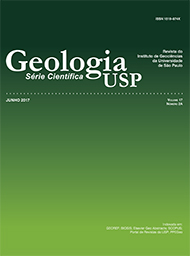Granulito Uyarani – a Pre-Cambrian structural window at the Bolivian Plateau: petrogenesis and tectonic meaning
DOI:
https://doi.org/10.11606/issn.2316-9095.v17-385Keywords:
Uyarani Granulite, Pre-Andean Basement, High-grade Metamorphism, Grenvillian-Sunsas Orogeny.Abstract
The pre-Andean basement consists of thirteen major paleoproterozoic terranes as well as the Arequipa-Antofalla Terrane, and among its outcrops occurs the Uyarani Granulite partially covered by Quaternary sediments, and a Pliocene ignimbrite. The Uyarani Granulite is characterized in this paper as a Felsic Granulite who presenting mafic enclaves of Mafic Granulite which had the protolith, respectively, syenogranites, granodiorites and quartz monzodiorites while the protolith of enclave has grabroic composition. The structural analysis reveals the polydeformed character of these rocks which have undergone three phases of deformation F1, F2 and F3 and a brittle event marked by F3 fractures and faults. The F1 stage is related to the M1 granulite facies metamorphism acting on the Uyarani Granulite, while the F2 phase is marked by M2, a greenschist facies retro-metamorphism. Lithochemistry reveals the felsic granulite has a calcium-alkaline signature, varying from metaluminous to peraluminous, magnesian magmatism. However, the enclaves reveal the existence of an associated basic magma, in magmatic arc setting with mixture of magmas. The crystallization age of felsic granulite, 1859 ± 200 Ma and 2020 ± 130 Ma, available in the literature, obtained respectively, by the Rb/Sr methods whole rock and U/Pb (TIMS) zircon, are contradictory and have high errors. The geochronological current analysis revealed a crystallization age, U/Pb (SHRIMP) zircon, of 1736 ± 5.1 Ma for the felsic granulite. The age of 1157 ± 60 Ma admitted until then as metamorphic peak, considering the lower intercept analysis concord diagram U/Pb zircon, it is also questionable. So, are considered in this work, the ages established by the methods Ar/Ar hornblende plateau age of 982 ± 2 Ma and Sm/Nd mineral isochron of 1008 ± 16 Ma, indicating the role of a regional thermal episode, coupled with the evolution of Grenvilliana-Sunsás Orogeny, also in granulite rocks studied, suggesting its connection with the moving tracks of Sunsás geochronological province at the SW of Amazon Craton.
Downloads
Downloads
Published
Issue
Section
License
Authors who publish in this journal shall comply with the following terms:
- Authors keep their copyright and grant to Geologia USP: Série Científica the right of first publication, with the paper under the Creative Commons BY-NC-SA license (summary of the license: https://creativecommons.org/licenses/by-nc-sa/4.0 | full text of the license: https://creativecommons.org/licenses/by-nc-sa/4.0/legalcode) that allows the non-commercial sharing of the paper and granting the proper copyrights of the first publication in this journal.
- Authors are authorized to take additional contracts separately, for non-exclusive distribution of the version of the paper published in this journal (publish in institutional repository or as a book chapter), granting the proper copyrights of first publication in this journal.
- Authors are allowed and encouraged to publish and distribute their paper online (in institutional repositories or their personal page) at any point before or during the editorial process, since this can generate productive changes as well as increase the impact and citation of the published paper (See The effect of Open Access and downloads on citation impact).





